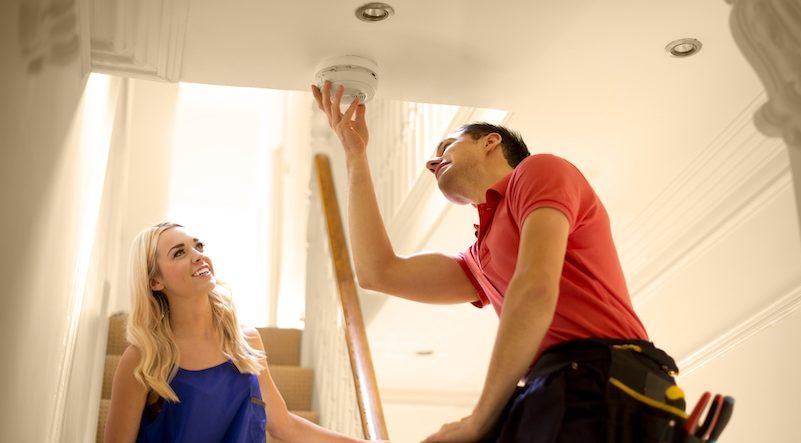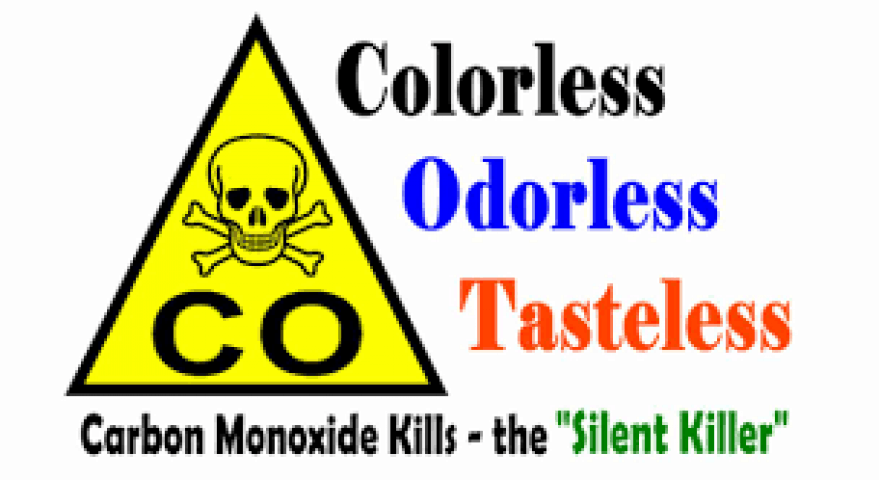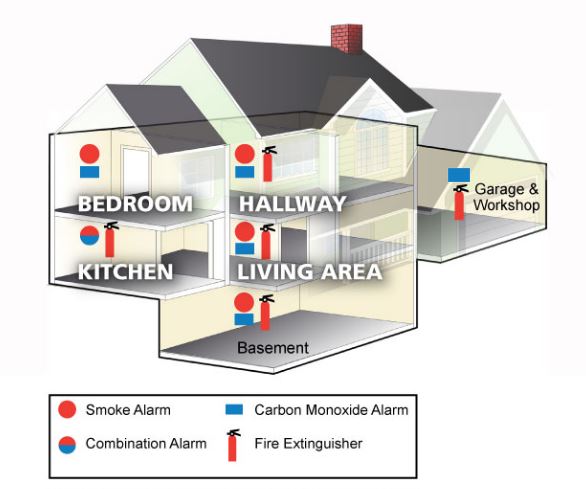
Estimated reading time: 11 minutes
During the cooler months, most homeowners close all windows and crank up the furnace to keep warm. This is a perfect time to not only test your carbon monoxide detectors to ensure they’re working correctly; it’s also a great time to check their placement to be sure they are able to accurately alert you and your family in the event of an emergency!
WHAT IS CARBON MONOXIDE?
Carbon monoxide is a gas that is highly toxic to humans and animals at high concentrations. You cannot detect the presence of CO in your home without the aid of a detector/alarm. This is because CO has no color, odor or taste. Which has earned it the name “silent killer”. It is for this reason that carbon monoxide detectors play a vital and life-saving role when installed in our homes.
How Carbon Monoxide Is Measured
CO is measured in a ratio called ppm (parts per million). Just as 10% means 10 out of 100, 10 ppm means 10 out of 1 million. So if your home has 10 ppm of carbon monoxide, there are 10 carbon monoxide molecules for every million molecules in the air.
Did you know all fuel-burning appliances in your home, including gas furnaces, produce some levels of carbon monoxide? Normally, those gasses are carried out of your home. However, if something goes wrong a CO leak can quickly become life-threatening to you and your loved ones. Therefore if you have fuel-burning appliances it’s extremely important to have carbon monoxide detectors properly installed to warn you of unsafe CO levels in your home.

So, where should carbon monoxide detectors be placed in order to accurately detect CO leaks in your home?
Carbon monoxide detector placement: Do’s

Getting the Height Right It is important to ensure your carbon monoxide detector is installed at a proper height where it can be most effective.
In a 2012 a study designed to determine the ideal placement of CO detectors in residential homes was conducted by academic publishing company Elsevier. During the study, researchers infused CO into an airtight Plexiglas chamber that had CO detectors placed at the top, middle and bottom. CO was infused into the chamber at three different heights, and each time researchers found that the level of CO equalized throughout the entire chamber. It did not become more concentrated in any one particular area, the study concluded that the height of the CO detectors did not matter. However, at Air Dynamics we recommend placing your detector at least 5 feet from the ground away from any obstructions and out of reach of young children who could unplug or inadvertently disable the detector.
Instead, residents should focus on ensuring there are enough CO detectors in the home and that they are being tested/replaced regularly as needed. According to the National Fire Protection Association (NFPA) CO detectors should be placed outside every single sleeping area and on every level of the home. It is possible that certain manufacturers will have specific instructions regarding the height of their detectors, and in that case, you should always follow the manufacturer’s instructions.
Air Dynamics further recommends considering interconnecting all of the CO detectors in your home. That way, all alarms will sound, safely alerting you and your family quickly no matter where the CO is concentrated.

For maximum protection of your home from excess levels of carbon monoxide, place your detectors in all of the following places:
- On every level of your home. In order to ensure that your home has maximum protection, it’s important to have a CO detector on every floor.
- Five feet from the ground. Carbon monoxide detectors can get the best reading of your home’s air when they are placed five feet from the ground away. Away from any obstructions and out of reach from young children who may accidentally unplug them.
- Near every sleeping area. Place your detectors close enough to every sleeping area so that they can easily awaken anyone sleeping in the event of an emergency. (Consider interconnecting them for better results)
- Near attached garages. Cars produce carbon monoxide when they are running. If your home has an attached garage, those gasses can quickly spread within your home. A CO detector near your attached garage will warn you if that becomes a problem.
- Where the manufacturer recommends. Every model of carbon monoxide detector is tested according to manufacturer specifications. It’s important to take those specifications into account when you’re deciding where to place your detectors.
Carbon monoxide detector placement: Don’ts

To ensure your alarm goes off only when needed, it is important to remember to place your CO detectors at least 15 feet away from any fuel-burning appliance. Some examples of this include a gas-powered kitchen stove/oven, gas dryer, furnace, gas water heaters and of course fireplaces.
Carbon Monoxide Detectors are designed to work within certain tolerances for temperature and humidity. For this reason, you should also avoid placing your detectors in any locations such as:
- Close to Appliances that generate heat
- Anywhere children can reach
- Near open windows or anywhere there could be a strong draft
- Behind curtains or sofas that may block the CO from reaching the sensor in time.
Air Dynamics suggests a single-function carbon monoxide alarm but we also advise that if you are installing a dual smoke-CO detector, place it on the ceiling so it can accurately detect smoke in addition to any dangerous CO levels in your living space.
BE AWARE
The following locations can either create a false alarm or prevent your detector from properly identifying the CO levels in your home:
- Within close proximity to any fuel-burning appliance.
- Located in excessively humid areas such as your bathroom.
- In direct sunlight.
- Near any sources of blowing air such as a fan, vent or open window.
What CO level is dangerous to my health?

Carbon monoxide is formed from the partial oxidation of carbon-containing compounds. When there is insufficient oxygen present to create carbon dioxide (which is not lethal).
This means that any time a fuel, such as wood, propane, gasoline or even oil are burned, carbon monoxide gas may be produced. This is especially true if appliances are defective or very old.
The health effects of CO directly depend on the amount of CO concentration, length of exposure and general health of any individuals exposed. The guide below will help you to understand the symptoms of excess CO and at what levels you should be more concerned.
| Level of CO | Health Effects, and Other Information |
| 0 PPM | Normal, fresh air. |
| 9 PPM | Maximum recommended indoor CO level (ASHRAE). |
| 10-24 PPM | Potential health effects with long-term exposure. |
| 35 PPM | Headache and dizziness within 6-8 hours of constant exposure. |
| 50 PPM | Maximum allowable concentration for continuous exposure for a healthy adult in any 8 hour period according to OSHA. |
| 100 PPM | Slight headache after 1-2 hours. |
| 125 PPM | Dizziness, drowsiness, and vomiting can occur. |
| 200 PPM | Dizziness, nausea, fatigue, headache after 2-3 hours of exposure. |
| 400 PPM | Headache and nausea after 1-2 hours of exposure. Life-threatening in 3 hours. |
| 800 PPM | Nausea, headache & dizziness after 45 minutes; collapse and unconsciousness after 1 hour of exposure. Death within 2-3 hours. |
| 1000 PPM | Loss of consciousness after 1 hour of exposure. |
| 1600 PPM | Dizziness, headache & nausea after 20 minutes of exposure. Death within 1-2 hours. |
| 3200 PPM | Headache, nausea, and dizziness after 5-10 minutes; potential collapse and unconsciousness after 30 minutes of exposure. Death within 1 hour. |
| 6400 PPM | Death within 30 minutes. |
| 12,800 PPM | Immediate physiological effects, unconsciousness. Death within 1-3 minutes of exposure. |
Do you need a Carbon Monoxide detector if you do not have gas on your property?
While we all try to do our utmost to protect ourselves and our loved ones from the dangers that lurk within our homes, carbon monoxide gas is one danger that is often overlooked. That is why this “silent killer” deserves more attention. Carbon monoxide poisoning is responsible for hundreds of deaths each year in the United States alone. But, these tragedies can easily be averted by simply using properly placed carbon monoxide detectors in our homes and workplaces.
According to the US Consumer Product Safety Commission, non-automotive consumer products are responsible for an average of about 170 deaths annually in the United States.
If you don’t have a:
- Oil or Gas Furnace
- Gas Clothes Dryer
- Gas Range
- Oil or Gas Space Heater
- Fireplace
- Gas Water Heater
- Charcoal Grill
- Wood-burning stove
- Attached Garage (fumes from automobiles and gas-powered lawnmowers or generators)
- Attached home (potential fumes from a neighbor who may have a fuel-burning appliance)

Then you may not be required to install one. However, considering the low cost of these devices and how deadly CO can be, why wouldn’t you want one? That’s like saying you don’t want a smoke detector because you don’t believe your home will catch fire.
Fuel-burning appliances are just one of many possible sources of CO in a home. Some others include:
- Electric ovens in self-clean mode. (When dirty the self-clean process carbonizes food residue releasing high levels of CO)
- Wood or coal-burning appliances such as fireplaces or stoves
- Candles and Incense burners
- Oil burning appliances (Furnace)
- Smoking indoors
- Gas burning appliances in attached garages (leaf blower, power washer, generator, vehicles, chainsaws, lawnmowers, etc.)
Consider this 0.5-5 ppm – According to the Environmental Protection Agency (EPA), this is the usual range for homes without gas stoves or other gas appliances. However, a simple wood-burning fire in your home can produce CO concentrations as high as 5,000 ppm a lethal level of carbon monoxide in enclosed spaces.
SYMPTOMS OF CARBON MONOXIDE POISONING
The symptoms of carbon monoxide poisoning are often confused with the flu and can be very similar to that of other types of poisoning and infections. Therefore making it difficult to pinpoint the difference. Below is a list of some common symptoms of CO poisoning which include:
- headache
- nausea
- weakness
- dizziness
- vomiting
- Infants tend to be unusually irritable and may lack interest in feeding

Some neurological symptoms of carbon monoxide poisoning include

- seizures
- disturbance in vision
- confusion
- disorientation
Pregnant women are particularly at risk, as carbon monoxide can have severe adverse effects on the fetus.
For more information on how to tell the difference between the flu and carbon monoxide poisoning please check out our blog All About Carbon Monoxide.
How Much CO is Too Much?
Long exposure to low levels of CO can be just as dangerous as shorter amounts of exposure to high levels of CO. Most alarms and detectors are designed only to alert you at high levels. This is where a carbon monoxide monitor can be especially helpful. So, what’s the difference?
A carbon monoxide detector is designed to actively monitor the amount of carbon monoxide levels in your air and provide you with a simple digital readout. This allows you to be more aware of when there are higher than normal amounts of CO in your home. Thus making it much easier to rectify any potential issues before they reach what your CO alarm deems to be dangerous.
What’s Better?
Above all, Air Dynamics encourages homeowners to consider purchasing a carbon monoxide monitor if you live with young children or elderly family members as they can be more susceptible to the effects of carbon monoxide poisoning. However, carbon monoxide monitors that include digital displays can be more expensive. If you are unable to purchase a CO monitor, having a carbon monoxide alarm or detector is far safer than having nothing at all.
YOU MIGHT ALSO LIKE:
Fall HVAC Maintenance Checklist
How To Protect Your HVAC System This Winter
Air Dynamics In-Home Carbon Monoxide Testing
Avoiding HVAC Scams During The COLD Weather Season
Warning Signs You May Have A Carbon Monoxide Leak In Your Home

We Service
Abington, Bensalem, Cheltenham, Churchville, Croydon, Elkins Park, Glenside, Holland, Horsham, Huntingdon Valley, Jenkintown, Langhorne, New Hope, Newtown, Philadelphia, Richboro, Southampton, Washington Crossing, Willow Grove, Yardley, and more
Counties Serviced Include:
Bucks, Burlington, Camden, Mercer, Montgomery & Philadelphia
